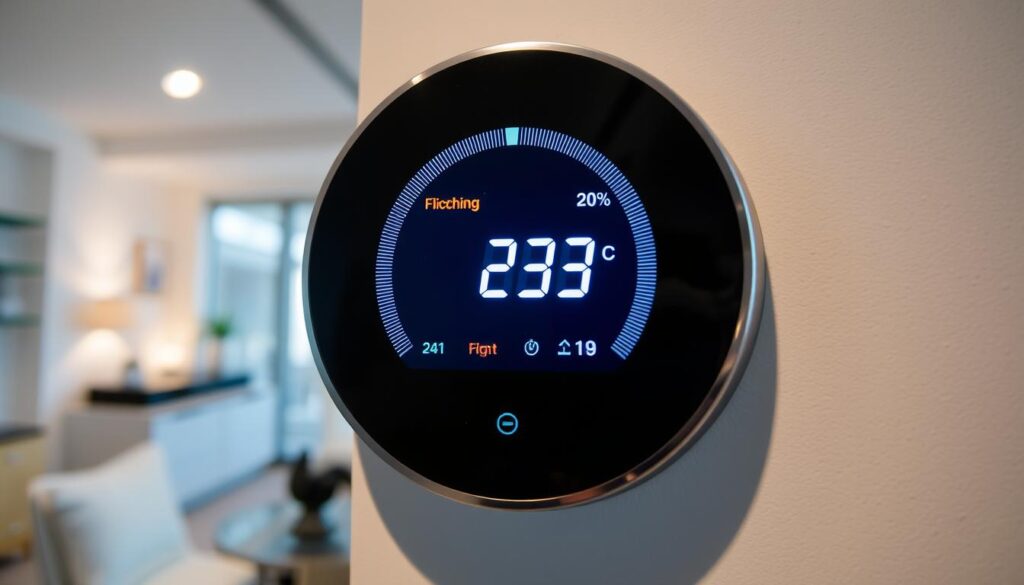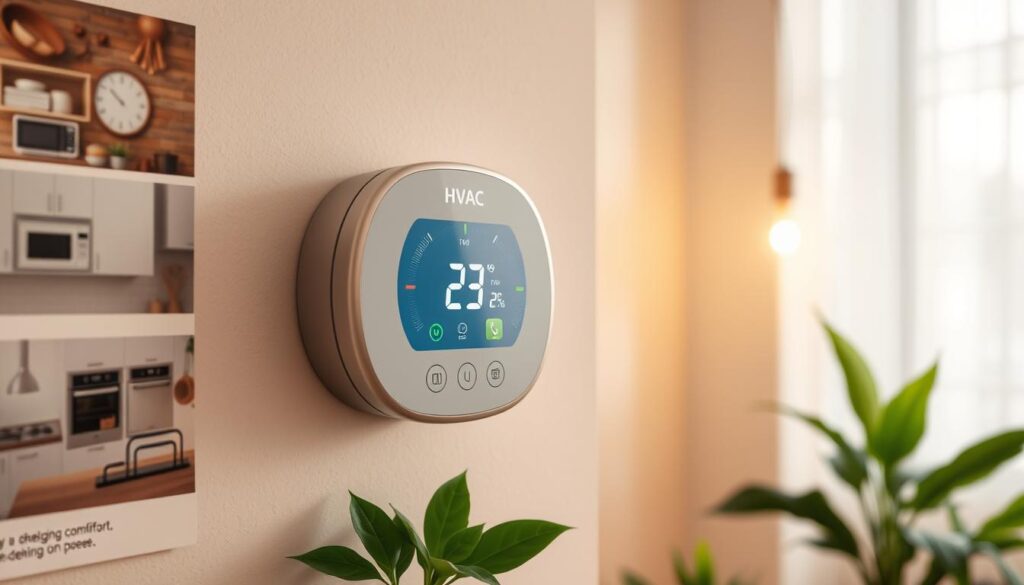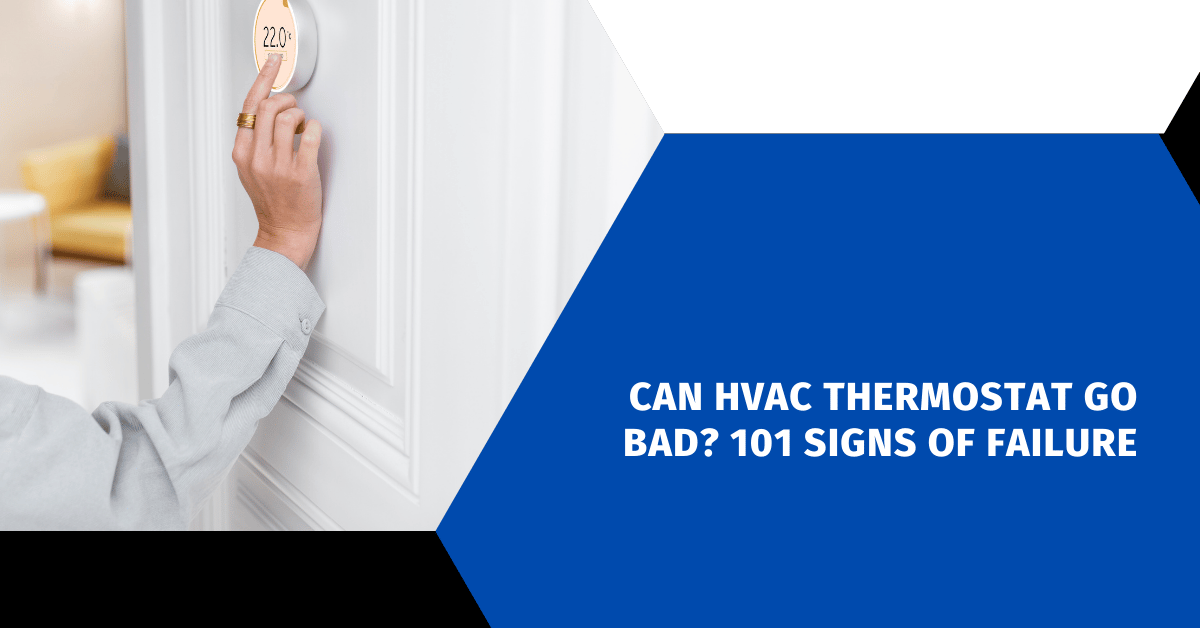Affiliate Disclosure
HVAC Guide Guys is a participant in the Amazon Services LLC Associates Program, an affiliate advertising program designed to provide a means for sites to earn advertising fees by advertising and linking to Amazon.
Can HVAC Thermostat Go Bad? As a homeowner, you count on your HVAC system to keep your home comfy all year. But what if the thermostat, the system’s core, starts to fail? Can an HVAC thermostat really go bad? And how can you spot the signs of trouble before it costs you a lot or breaks the whole system?

In this article, we’ll explore the common reasons and warning signs of HVAC thermostat failure. We’ll give you the tools to tackle any issues early on. Whether it’s random system behavior, temperature issues, or controls that won’t respond, knowing your thermostat’s health is key to your HVAC system’s efficiency and life span.
Key Takeaways
- HVAC thermostats can wear out over time, causing various problems.
- Spotting signs of thermostat failure, like odd system behavior, wrong temperature readings, and controls that won’t work, can prevent discomfort and inefficiency in your home’s heating and cooling.
- Bad thermostats can make your energy bills go up, as the HVAC system works harder to make up for the problem.
- Regular upkeep and replacing old thermostats can keep your HVAC system running well and save energy.
- Switching to smart thermostat technology can bring you advanced features and better control over your home’s climate.
Table of Contents
Understanding HVAC Thermostat Functionality
Thermostats are key to your HVAC system’s smooth operation. They connect your home to the heating and cooling equipment. They keep an eye on the temperature and adjust it to keep your home comfortable. Knowing how your thermostat works helps you see its role in temperature regulation and HVAC communication.
How Your Thermostat Communicates with HVAC System
Your thermostat always checks the home’s temperature and tells the HVAC system when to heat or cool. This thermostat operation uses electronic signals. The thermostat sends these signals to the furnace or air conditioner.
Components of a Modern Thermostat
Today’s thermostats have advanced features. They include:
- Temperature sensors to accurately measure the indoor temperature
- Digital displays to show the current and desired temperature settings
- Control buttons or touchpads for adjusting the temperature and programming settings
- Wiring connections to link the thermostat to the HVAC system
- Microprocessors to process temperature data and issue commands
Role in Temperature Control
The main job of a thermostat is to keep the indoor temperature steady and comfortable. It watches the environment and talks to the HVAC system. If the temperature gets off track, it tells the system to turn on or off. This keeps the temperature regulation right where you want it.
“Thermostats are the heart of any HVAC system, serving as the essential link between your home and the equipment responsible for heating and cooling it.”
Common Causes of Thermostat Failure
Your HVAC thermostat is key to keeping your home comfortable and energy-efficient. But, like any electronic, it can face problems that cause malfunctions or failures. Knowing why thermostats fail can help you fix issues early.
One big reason for thermostat malfunction is a lack of power. Experts say power issues are a top cause of HVAC thermostat problems. This can happen if batteries die, circuit breakers trip, or if there’s a power cut.
Wiring problems can also cause trouble. Issues like frayed or loose connections can mess up communication between the thermostat and your HVAC system. Regular checks and maintenance can prevent these problems.
Dirt, dust, and debris can also cause thermostat issues. These can block the thermostat’s electrical and mechanical parts, leading to wrong temperature readings. Cleaning with compressed air or a soft brush can keep your thermostat working well.
Where you place your thermostat matters too. Putting it near vents, windows, or in sunlight can give wrong readings and shut off your system too soon. Move it to a central, well-ventilated spot in your home.
If you can’t fix HVAC thermostat problems yourself, get help from a pro. A skilled HVAC technician can find and fix complex issues. This ensures your system works right and saves energy.
“Proper thermostat placement and regular maintenance are key to preventing common thermostat malfunction reasons and ensuring the longevity of your HVAC system.”
Explore Our HVAC Shop
Looking for top-rated HVAC tools, parts, and accessories? Visit our shop and find the perfect solution for your needs.
Visit the ShopCan HVAC Thermostat Go Bad? Key Warning Signs
Your HVAC system’s thermostat is key to keeping your home’s temperature right. But, like all electronics, thermostats can fail. Spotting the signs of a bad thermostat helps keep your home comfy and energy-smart.
Random System Operation
A failing thermostat often shows up as your HVAC system acting weird. If it turns on and off without reason, it might mean the thermostat is not working right.
Temperature Reading Inconsistencies
Another sign is when the thermostat shows a different temperature than the room. This can make your system work too long, wasting energy and making your home less comfy.
Unresponsive Controls
Not being able to change the temperature on your thermostat is a big red flag. It could be a wiring problem or something inside the thermostat gone wrong.
Noticing these signs early can help fix your thermostat before it causes bigger HVAC problems. Fixing thermostat issues quickly keeps your home comfy, saves energy, and keeps your heating and cooling system running well.
If you see any of these signs or your HVAC system is acting strange, you need to check it out. A bad thermostat can really mess with your home’s comfort and energy use. So, it’s important to fix it before it gets worse and costs more.
Explore Our HVAC Shop
Looking for top-rated HVAC tools, parts, and accessories? Visit our shop and find the perfect solution for your needs.
Visit the ShopSigns of Incorrect Temperature Readings
If your home feels warmer or cooler than the thermostat says, it might be time to check your HVAC thermostat. Incorrect temperature readings often mean the thermostat is not working right. You can use a handheld ambient air thermometer to check if the readings match.
One big reason for wrong temperature readings is where you put the thermostat. If it’s in direct sunlight or near heat, it won’t read the air temperature right. Also, older thermostats with mercury sensors need to be level to get accurate readings.
Another reason for temperature issues is an old thermostat. Over time, its parts can wear out, causing it to malfunction. Getting a new, smart thermostat can help keep your home’s temperature steady.
If your HVAC system keeps turning on and off or doesn’t change temperature, it might be the thermostat’s fault. A professional HVAC technician should check it to fix the problem and save energy.
To keep your thermostat accuracy and avoid temperature discrepancies, check the battery and clean the sensors often. Make sure the thermostat is in the right spot. Fixing these issues will help your HVAC system work better and keep your home comfortable.
Impact of Aging Thermostats on HVAC Performance
As your home’s thermostat gets older, it can really affect your HVAC system’s performance. Most thermostats last about 10 years before they start to have problems. They might need to be replaced.
Average Lifespan of Thermostats
Thermostats can lose their accuracy over time. They might not respond well to your commands. This can cause uneven temperatures in your home and make your HVAC system work harder. It uses more energy, too.
Technology Obsolescence Factors
Newer HVAC control technology can make old thermostats outdated fast. Getting a new thermostat can improve your system’s efficiency. It can also save you money on your energy bills.
Also, a bad or old thermostat can cause problems like short-cycling. This can damage your HVAC system and make it fail early. Getting a new thermostat is a smart move to keep your home comfortable.
“The thermostat is considered the brain of HVAC systems, controlling when systems turn on and the temperature settings, highlighting the crucial role of quality and proper use.”
Explore Our HVAC Shop
Looking for top-rated HVAC tools, parts, and accessories? Visit our shop and find the perfect solution for your needs.
Visit the ShopEnergy Bill Spikes and Thermostat Malfunction
Have you seen your energy bills go up without knowing why? It might be your HVAC thermostat. A bad thermostat can make your energy use go up and your bills higher. It doesn’t talk right to your heating and cooling system.
A thermostat that’s not working right makes your HVAC system work too hard. This means it uses more energy and costs you more money. Problems can be because it doesn’t read temperatures right, doesn’t respond, or can’t talk to the HVAC.
Thermostats usually last about 10 years. As they get older, they can start to have problems. Newer thermostats can also make old ones seem outdated.
“Setting the thermostat at 78 degrees Fahrenheit in summer can lead to increased energy efficiency,” explains HVAC expert, Jane Smith. “Upgrading to a more modern and efficient air conditioner or heat pump can also help in reducing energy costs.”
If you think your thermostat is causing high energy bills, get a pro to check it. They can find out what’s wrong and tell you what to do. This might mean just fixing it or getting a new one.

Fixing thermostat problems can make your HVAC system work better. This can lower your energy bills. Keeping your heating and cooling in good shape helps keep your bills down.
Explore Our HVAC Shop
Looking for top-rated HVAC tools, parts, and accessories? Visit our shop and find the perfect solution for your needs.
Visit the ShopShort Cycling: A Major Red Flag
Homeowners often face a big problem with their HVAC systems: HVAC short cycling. This happens when the system turns on and off too much, never fully heating or cooling. It might seem like a small issue, but short cycling can hide big problems, often tied to thermostat-related inefficiency.
Causes of Short Cycling
Short cycling usually comes from a faulty thermostat. It can’t read temperatures right, causing the system to start and stop too soon. Other problems, like the HVAC being too big or too small, can also cause it.
Impact on System Efficiency
When the HVAC system starts and stops a lot, it wears out faster. This shortens its life and makes it less efficient, raising your energy bills. It also makes your home’s temperature uneven, making it uncomfortable and risking system failure.
If your HVAC system is always turning on and off, get a pro to check it. Fixing the short cycling problem can make your system work better, last longer, and keep your home comfy all year.
Power Issues and Battery-Related Problems
Keeping your thermostat working right is key for your HVAC system to run well. Power problems often cause thermostat issues. Knowing the signs and causes can help fix these problems fast.
Batteries in thermostats can go dead or weak, making the device not work right. Most modern thermostats use AA or AAA batteries. These batteries need to be changed when they run out. Look for a dim or unresponsive display, weird temperature readings, and slow startup or shutdown. Swapping out the batteries is easy and can fix these issues quickly.
For hardwired thermostats, power issues can come from many places. Loose connections, tripped circuit breakers, safety switch problems, bad wiring, or transformer failures can block power to the thermostat. If your thermostat looks blank or won’t respond, check the power source first. This is before you think it’s a bigger problem.
| Power-Related Thermostat Issues | Percentage of Cases |
|---|---|
| Accidental shut-offs or mishandling | 30% |
| Battery-related problems | 15% |
| Environmental factors (dirt, debris) | 8% |
| Electrical issues (circuit breakers, wiring, etc.) | 21% |
| Resolved by changing batteries or turning on | 55% |
| Require more in-depth troubleshooting | 45% |
Fixing thermostat power failure and battery replacement issues can often fix your HVAC system. If the problem keeps coming back, it’s time to call a pro HVAC tech for a detailed check and fix.
Explore Our HVAC Shop
Looking for top-rated HVAC tools, parts, and accessories? Visit our shop and find the perfect solution for your needs.
Visit the ShopModern Thermostat Options and Upgrades
Upgrading your home’s thermostat can save you money and make your life easier. Today’s thermostats have cool features that help you control your home’s temperature better. They also save you money on your utility bills.
Smart Thermostats
Smart thermostats are the latest in thermostat tech. They learn your temperature likes and set schedules for your HVAC. You can control them from your phone or with voice commands.
They work with other smart home devices too. This makes your home even more connected and convenient.
Programmable Features
Programmable thermostats have improved a lot. You can set them to change the temperature at different times. This keeps your home comfy when you’re there and saves energy when you’re not.
Remote Control Capabilities
Modern thermostats let you control your home’s temperature from anywhere. You can use a smartphone app or voice commands. This means your home is always just right, even when you’re not there.
Getting a new thermostat can really improve your home. You’ll save energy, get better temperature control, and enjoy more convenience. Whether you pick a smart or programmable thermostat, it’s a smart choice for your home.

When to Call a Professional HVAC Technician
Some thermostat problems can be fixed easily, but others need a pro. If you’ve tried simple fixes like replacing the battery and your thermostat still malfunctions, it’s time to call an HVAC technician. They can find out what’s wrong, whether it’s a faulty thermostat or a bigger issue with your HVAC system. They also know how to install new thermostats right, making sure they work perfectly.
Most thermostats last about ten years. If yours is older than that and not working well, it might be time for a new one. A bad thermostat can make your HVAC system work too hard, wasting energy and raising your bills.
As thermostats get older, their wiring can get damaged. This can mess up how the thermostat talks to your HVAC system. If your thermostat isn’t working right, it might not show the correct temperature. Getting a new programmable or smart thermostat can make your home more efficient and easier to control from afar.
- Problems with the relay switch, motherboard, or wiring may result in the heater or air conditioner not turning on or shutting off as intended.
- If a thermostat doesn’t respond to setting changes promptly, it indicates a potential issue with the thermostat going bad and needing replacement.
- Lack of power, shown by a thermostat not lighting up or responding, may signify a need for a replacement.
It’s best to call a professional HVAC technician if your thermostat isn’t working right. They can figure out what’s wrong and fix it, making sure your HVAC system runs smoothly. This keeps your home comfortable and energy-efficient.
Explore Our HVAC Shop
Looking for top-rated HVAC tools, parts, and accessories? Visit our shop and find the perfect solution for your needs.
Visit the ShopDIY Thermostat Troubleshooting Steps
Before you call a pro, try some DIY steps to fix your thermostat. This can save you time and money. It might even stop you from needing a service call.
First, check your thermostat settings. Make sure it’s in the right mode and the temperature is set correctly. If it’s battery-powered, swap out the batteries to check for power issues.
Next, clean your thermostat. Dust or dirt can mess with its thermostat self-diagnosis and home HVAC maintenance. Also, check the wiring to the HVAC system. It should be tight and not damaged.
- Check thermostat settings and ensure it’s in the correct mode
- Replace batteries if the thermostat is battery-powered
- Clean the thermostat of dust and debris
- Inspect wiring connections to the HVAC system
If these steps don’t fix the problem, it’s time to call a pro. They can do a full check, find the problem, and fix it. This will make sure your thermostat self-diagnosis and home HVAC maintenance are top-notch.
“Proper maintenance and troubleshooting of your home’s thermostat can go a long way in ensuring your HVAC system operates efficiently and reliably.”
| Common Thermostat Issues | Potential Causes |
|---|---|
| Random system operation | Wiring issues, faulty control board, power problems |
| Temperature reading inconsistencies | Sensor malfunction, improper thermostat placement, airflow obstructions |
| Unresponsive controls | Dead batteries, loose wiring, programming errors |
Conclusion
Keeping your HVAC system in top shape is key. This means regular thermostat maintenance and quick action on any problems. Spotting signs like temperature issues or unresponsive controls early can help avoid bigger HVAC troubles.
Fixing thermostat problems, big or small, boosts your HVAC system care. Working with pros like The Comfort Authority ensures your system runs smoothly. This means better energy use and longer system life.
Switching to a smart thermostat adds convenience and control. It also helps your system work better and last longer. Regular upkeep and quick fixes are vital for a comfy home and efficient heating and cooling.

